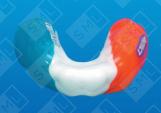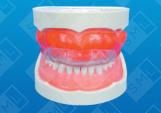
Mouthguards
Location
Most individuals wear a mouth guard during sports in an effort to prevent damage to their teeth. The new generation of mouth guards have shown to reduce forces that not only protect the teeth, but also can prevent concussions, neck injuries, jaw fractures, cerebral hemorrhage and even death. This is accomplished by separating the jaws to prevent the condyles from being displaced upward and backward against the wall of the glenoid fossa. The proper use of a mouth guard can reduce the incidence and severity of injuries during sports and athletic activities of any type.
Every person in your practice -- involved in any athletic activity where contact can be made or a fall can occur -- should be using an athletic mouth guard. To get patients to wear a mouth guard on a regular basis, it must be comfortable. It must not impair breathing and it must permit normal speech. Mouth guards are most commonly made for the maxillary arch. For the athlete with a prognathic mandible, it is recommended that a custom mouth guard be made to cover the mandibular arch as well.
Prior to delivering the mouthguard, you will need to:
- Complete an oral exam to ensure that the patient is in good dental health
- Treat all new or recurrent caries prior to the fabrication of a mouthguard
- Take special care when designing mouthguards for the edentulous patient
- Remove removable prosthodontic devices (appliances) prior to taking impressions for the mouthguard...and instruct the patient to remove these appliances while wearing the mouth guard
- For serious athletes in a contact sport: have their third molars -- most frequent site of mandibular fractures -- evaluated for possible extraction
- Block out (on the model prior to appliance fabrication) any area where teeth will be erupting
- Modify mouth guards to allow for anticipated changes over a 3-month period
Upon delivery, take some time to discuss how to wear, clean and store the appliance. The mouthguard should be kept moist to maintain its flexibility and resilience. After use, it should be scrubbed with a toothbrush and placed in a container.
Select another Appliance Category












